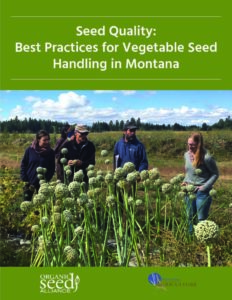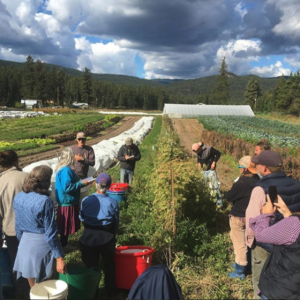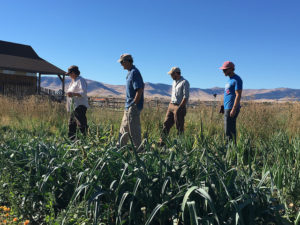
Farmers need seed that meets specific quality standards, including seed that is free of disease and that delivers on advertised germination rates, vigor, trueness to type, and specific traits for a particular variety. A new manual published today, Seed Quality: Best Practices for Vegetable Seed Handling in Montana, provides specific recommendations to help ensure the quality of seed Montana’s specialty crop growers produce. The practices detailed in the manual focus on growers who primarily sell vegetable seed. The manual includes detailed recommendations for conducting quality assurance grow outs, germination testing, and vigor testing, and for managing foundation and stock seed.
The quality assurance manual addresses issues that are relevant to a national audience while focusing on instruction and resources specific to Montana specialty crop seed growers, such as state noxious weed restrictions. The manual includes an in-depth guide to understanding seed quality standards and is being released in conjunction with 10 crop-specific summaries of best practices for seed production.
“One of our goals is to empower growers to expand their specialty crop seed production by understanding how to reduce risks associated with organic seed production and handling,” says OSA Program Director Micaela Colley. “The practices described in these guides can immediately be adopted by farmers to improve their skills in seed production and handling, and, ultimately, to increase the quality and diversity of organic specialty crop seed available for Montana agriculture.”

These resources are published at a time when organic specialty crop growers in the state say they need more suitable varieties for their climates and production systems. In 2016, OSA conducted a survey of these Montana producers and found that 60% of respondents said there are vegetable crops they won’t grow because of disease and insect problems. More than half of respondents said there are varieties they wish they still had access to but can no longer find in catalogues. Nearly half of respondents report growing seed for on-farm use and nearly a third are selling seed to a wholesale market.
Seed Quality provides a comprehensive look at the many facets of producing high-quality organic seed. Growers and seed companies in need of handling practice standards will find it to be a helpful reference. The manual includes specific guidelines and recommendations, but also instructs growers and businesses on how to implement procedures that are right for them, whether they’re developing a new seed business or professionalizing a current commercial seed operation.
“Montana’s climate places it in the perfect position to become a competitive state in the world of organic seed growing,” says Tessa Peters, lead author of Seed Quality and who also manages OSA’s research and education programs in the Intermountain West. “The resources released today will help Montana’s vegetable seed growers support the burgeoning organic seed industry by filling regional supply gaps.”
Seed production requires knowledge and a skill set that goes beyond what’s required to grow a vegetable crop for eating. Because some seed quality issues can be addressed through production practices, Seed Quality is being released in conjunction with new crop-specific summaries of best practices for growing seed. These best practices cover the production of seed from 10 vegetable crops identified as important to Montana producers:
Beet Seed Production: Quick Reference
Broccoli Seed Production: Quick Reference
Carrot Seed Production: Quick Reference
Cucumber Seed Production: Quick Reference
Kale Seed Production: Quick Reference
Onion Seed Production: Quick Reference
Snap Bean Seed Production: Quick Reference
Sweet Corn Seed Production: Quick Reference
Tomato Seed Production: Quick Reference
Winter Squash Seed Production: Quick Reference
Although the organic seed trade is growing, the supply still doesn’t fully meet the diverse and regional needs of all growers, including farmers in Montana and the broader Intermountain West. The vast majority of seed production occurs in high-input, conventional farming systems – production that depends on external chemical inputs to support yield and quality. Organic systems differ from conventional ones in a number of ways, including the timing of nutrient availability, the variability of field conditions, and the amount of insect, disease, and weed pressure.
With a limited number of options to combat production problems, organic farmers rely on prevention through crop rotation, soil management strategies, and the use of appropriate crop genetics. While progress has been made in developing best management practices, little has been done to develop varieties suited to organic systems – a strategy that could be equally important over time.

As part of this project, OSA also worked with five organic seed growers to conduct variety trials and begin selections to adapt specific crop varieties to Montana’s unique climates and environmental conditions.
“Increasing the number of varieties grown in and for organic systems is essential to supporting the success of organic farmers,” Peters says. “It all starts with the seed.”
All of these resources can be found in OSA’s online publication library.
This project was made possible thanks to the Montana Department of Agriculture’s Specialty Crop Block Grant Program.
